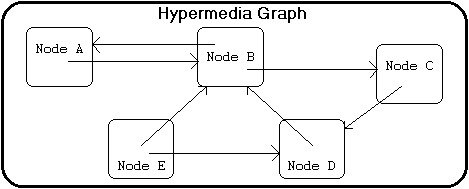
Parent Level | |
Current level | |
| |
Child Level | |
| |
| |
|
Hypermedia - Introduction
Contents in Current Page:
- Hypermedia - Introduction
- Hypermedia - Limitations, problems
- Hypermedia - Basic Hypermedia Model
- Hypermedia - Data Submodel
- Hypermedia - Process Submodel
Hypermedia is a style of building systems for organising, structuring and accessing information around a network of multimedia nodes connected together by links (Conclin, 1987). The general Structure of hypermedia allowed hypermedia to be applied to a wide variety of task domains. We can distinguish hypermedia systems in two generations (Halasz, 1988). First generation hypertext systems were mainframe based, text-only systems for augmenting the performance of information processing environments, storing the whole world's literature or for supporting traditional writing and reading. Transition from hypertext to hypermedia took place with the Second Generation Systems. These systems were quite similar in concept with first generation hypertext systems, but they were workstation and PC based, with more sophisticated graphics interfaces and support to other forms of information such as graphics, sound, animation, video.
Hypermedia - Limitations, problems
While hypermedia has become more popular and hypermedia systems come into more widespread use, limitations and shortcomings of current hypermedia are becoming increasingly apparent (Halasz, 1988). The simple basic hypermedia model is not rich enough to support the organising, structuring and accessing tasks required by many applications (Hammond, 1993). Problems like user Disorientation, development of user Cognitive Overhead and manual construction of information network dominate current hypermedia systems (Ramaiah, 1992). Hypermedia Problems are interrelated (Charles, 1993). For example when users are disoriented the development of high cognitive overhead is very possible. Additionally, applicability of general purpose hypermedia systems to specific tasks is problematic for casual non programmer users.
Manual construction of hyperme
Hypermedia - Basic Hypermedia Model
Virtually, all hypermedia systems are founded in basic hypermedia model. Likewise, a large part of current hypermedia research assumes the underlying existence of this basic model (Rivlin et all, 1994). Thus, it would be useful if we define the basic hypermedia model. We can divide basic hypermedia model in two distinguished but interdependent submodels. The first one is the data submodel. According to this submodel Nodes are interconnected with directed Links forming the structure of a directed graph (Parunak, 1991). Addition, deletion, update of nodes, links are valid operations. Process submodel is the second element of basic hypermedia model. This submodel concerns the information access mechanisms of information network. Figure 2 shows the data and process submodels of basic hypermedia model. This model is foremost characterised by its generality, flexibility and incompleteness. For example, E.F Codd in his ACM Turing award lecture (Codd, 1981) defines a data model as a combination of a data structure, operations and integrity rules. In this sense, hypermedia data model is incomplete, since it does not define any constraints (e.g. is valid the insertion of a link without associate it to a destination node, see Gronbajek et all, 1994) for determining the consistency of information network. On the other side, process submodel is very primitive, without using detailed specifications for defining navigation access (e.g, how a user activates a link ).

Nodes are the primitive unit for organising information in hypermedia network. Nodes function as collections of primitive unstructured data which are bind together in order to create one logical entity. The purpose of this logical entity should be to provide a coherent information abstraction to existing information space. For example, in a hypermedia system about the Aristotle's life, a node can combine a text description, a sound information, a graphics picture and a digital video about the Aristotle's birthplace, Stagyra. Links are the other fundamental units of data submodel. Links implement the directed interconnections between nodes. They are Anchored to a departure node and provide the hypermedia user the ability to activate them and move to the destination node. Links are associated with parts of departure nodes rather than with the node as a whole. This is less frequently for associations between links and destination nodes. A simple variation of this model can be achieved, regarding links as undirected interconnections between nodes than directed (Halasz, 1994). But, since most of hypermedia systems don't support bi-directional links we can not assume undirected links as part of the basic hypermedia model. Figure 1 shows a graphical representation of a simple hypermedia information network consisting of five nodes and several directed links between nodes.

Hypermedia concept is not only organised multimedia data interconnected with links. Navigation, whereby the user moves through the hypermedia network by activating and following links from one node to another, is another defining feature of hypermedia (Nielsen, 1990B). Navigation is the primary means to access information in hypermedia network, composing the most essential aspect of basic hypermedia process submodel. The basic characteristic of navigational access is that users navigate by self motivation without having any external navigational aid. Some primary navigational functionality like the ability to backtrack to previous visited node, or to move the very first visited node, could be regarded as part of basic process submodel.